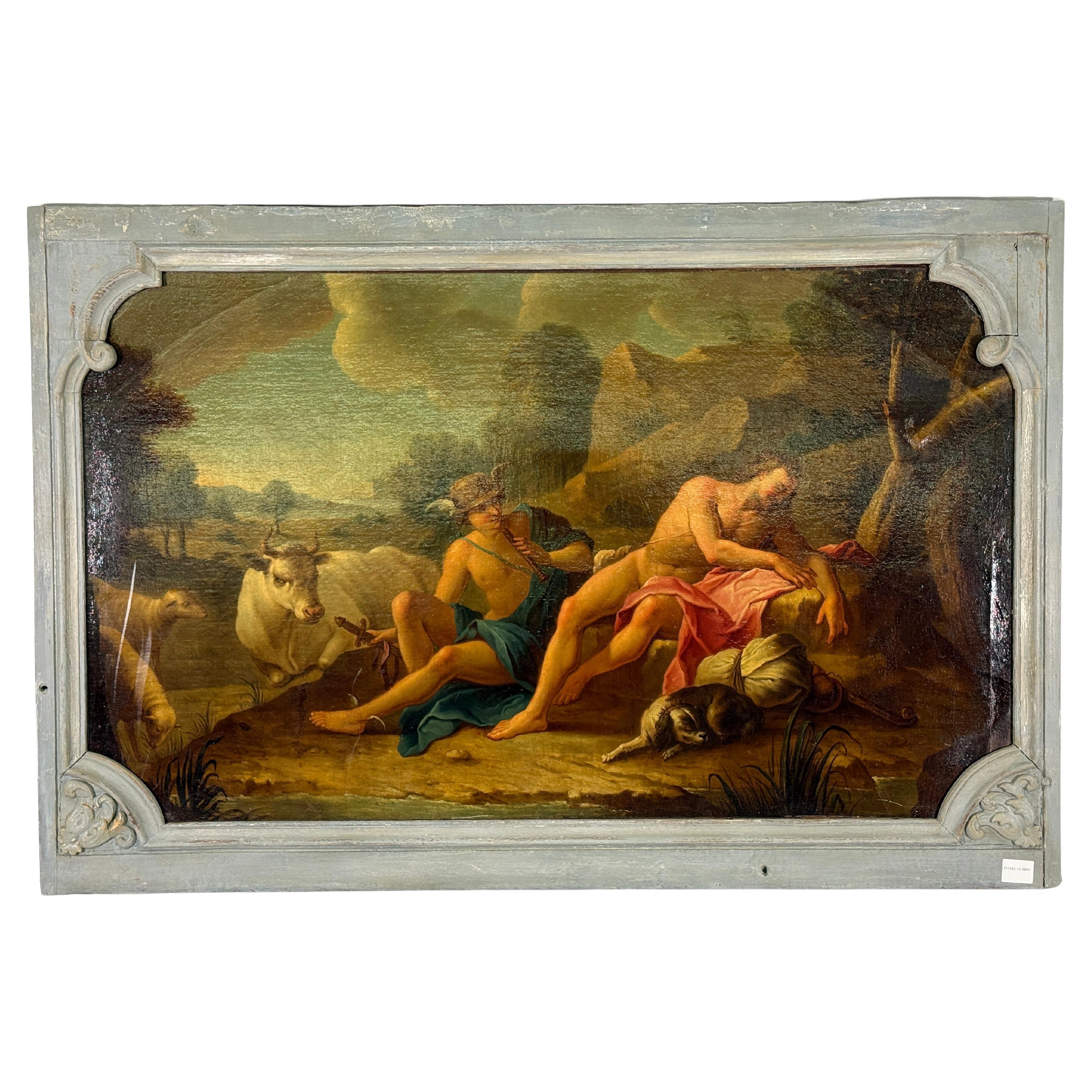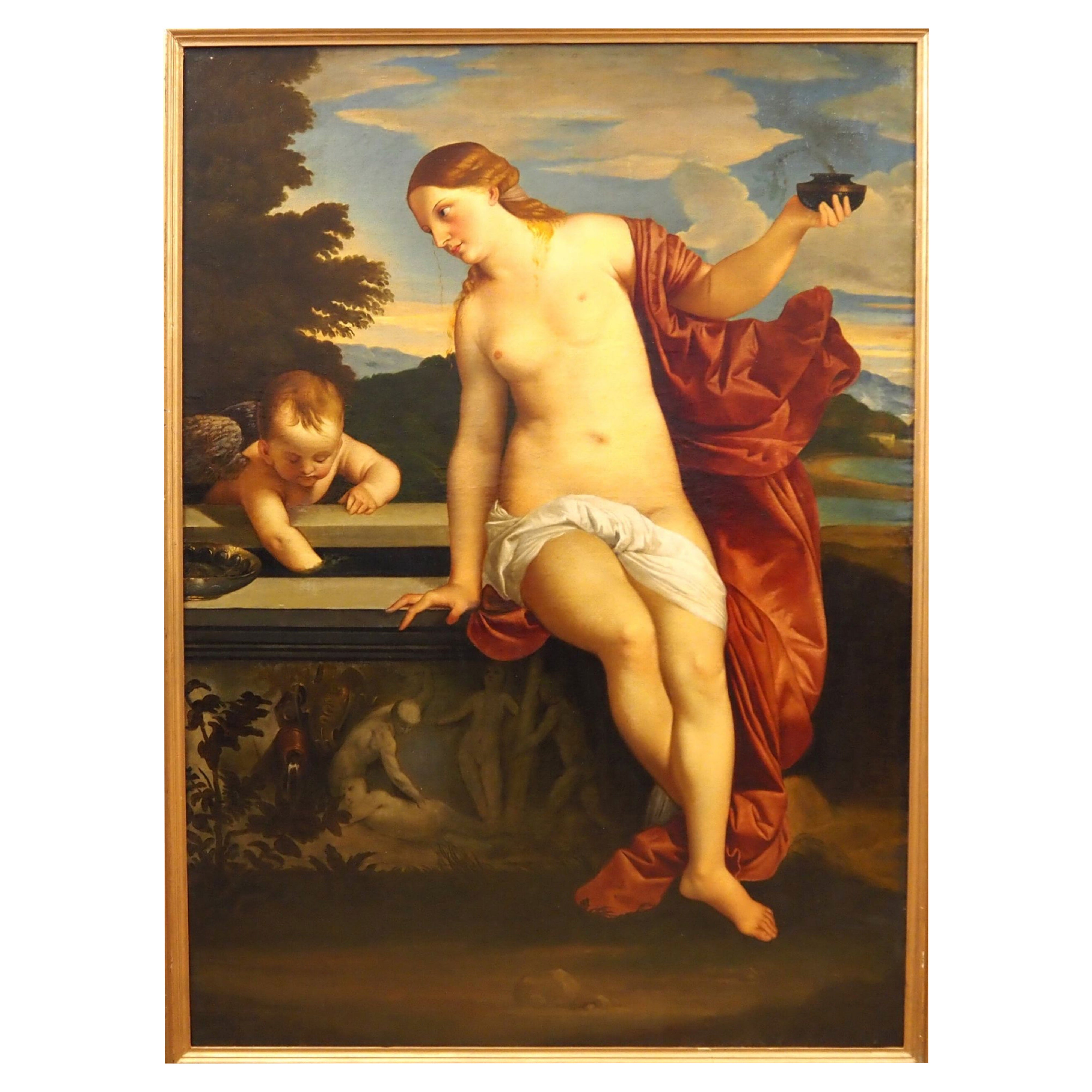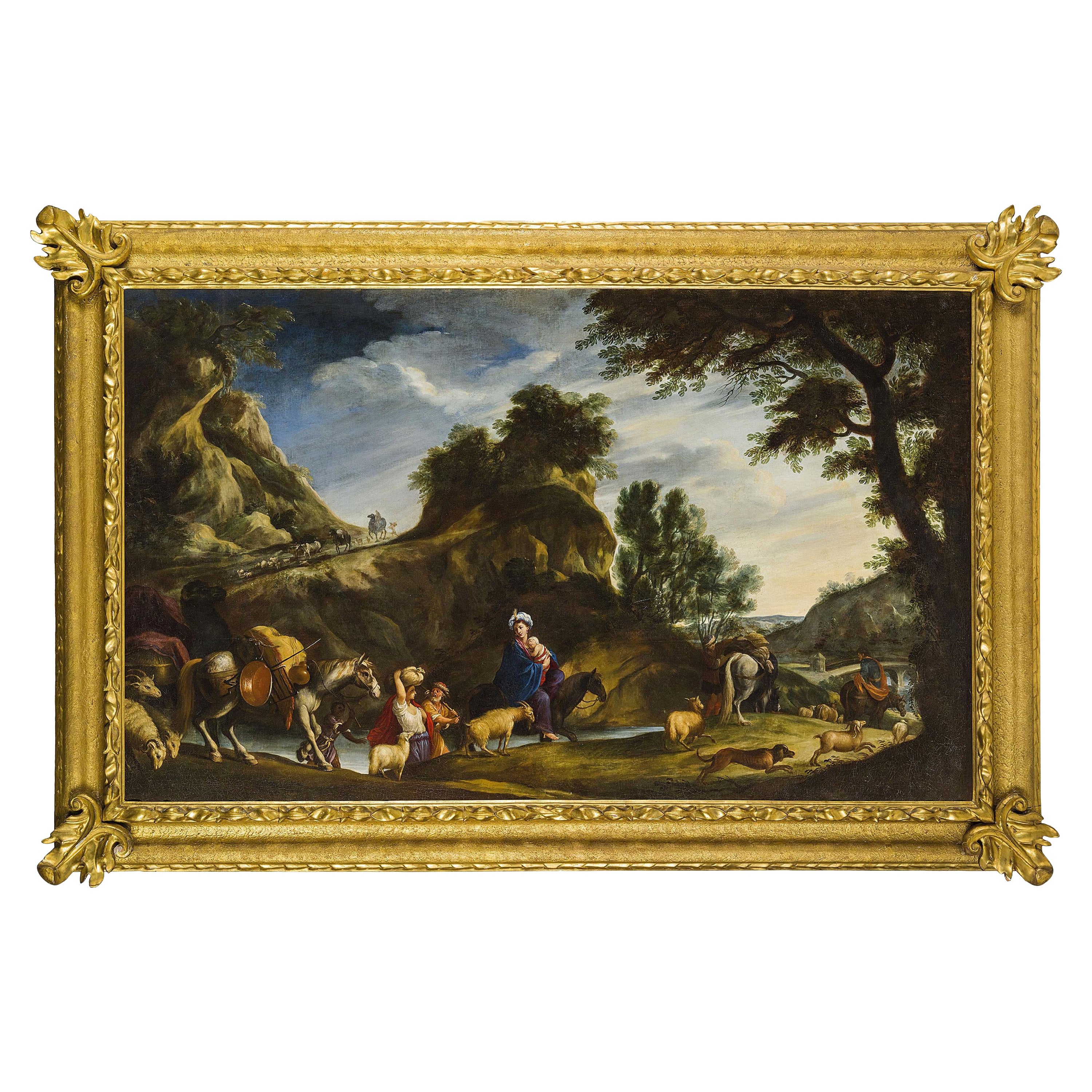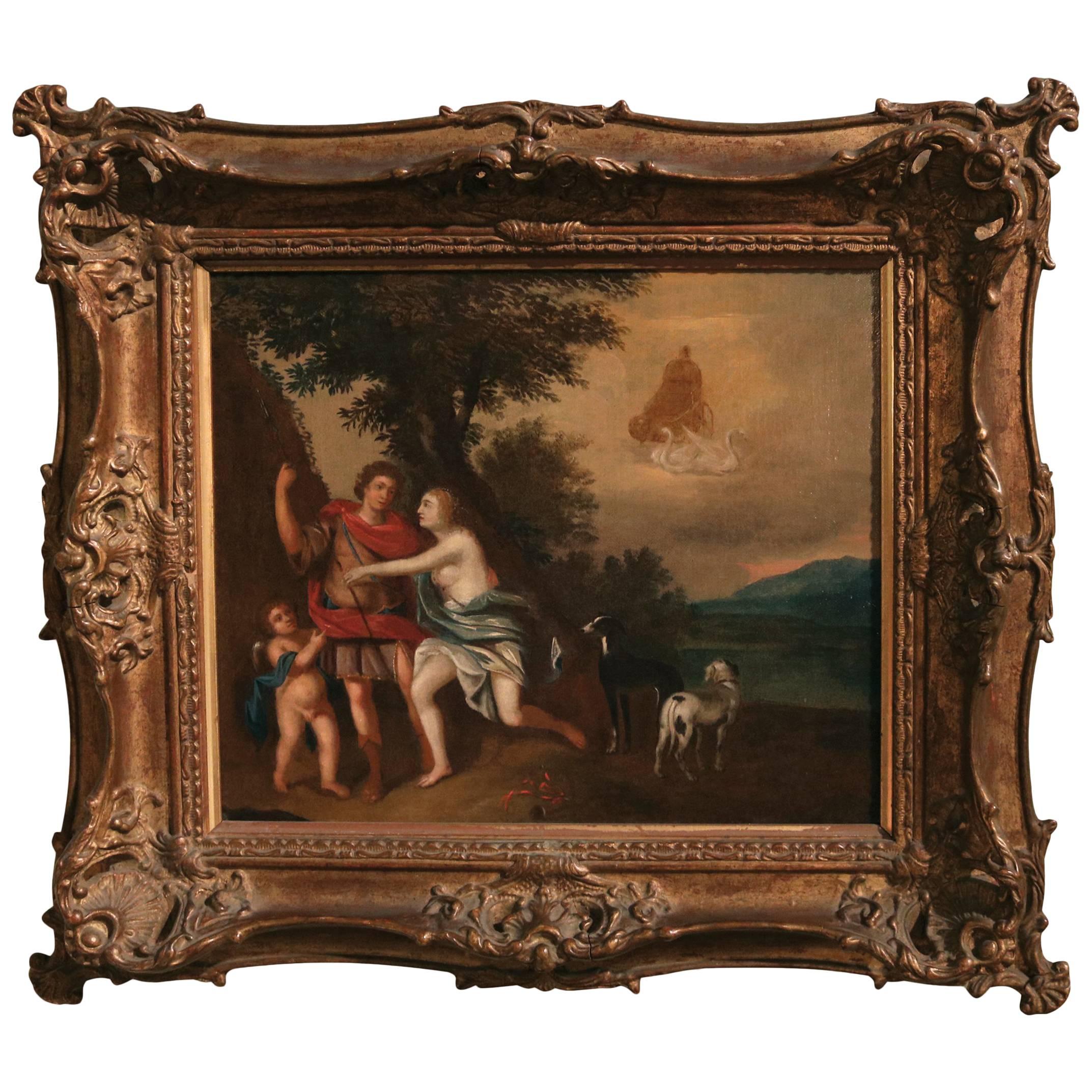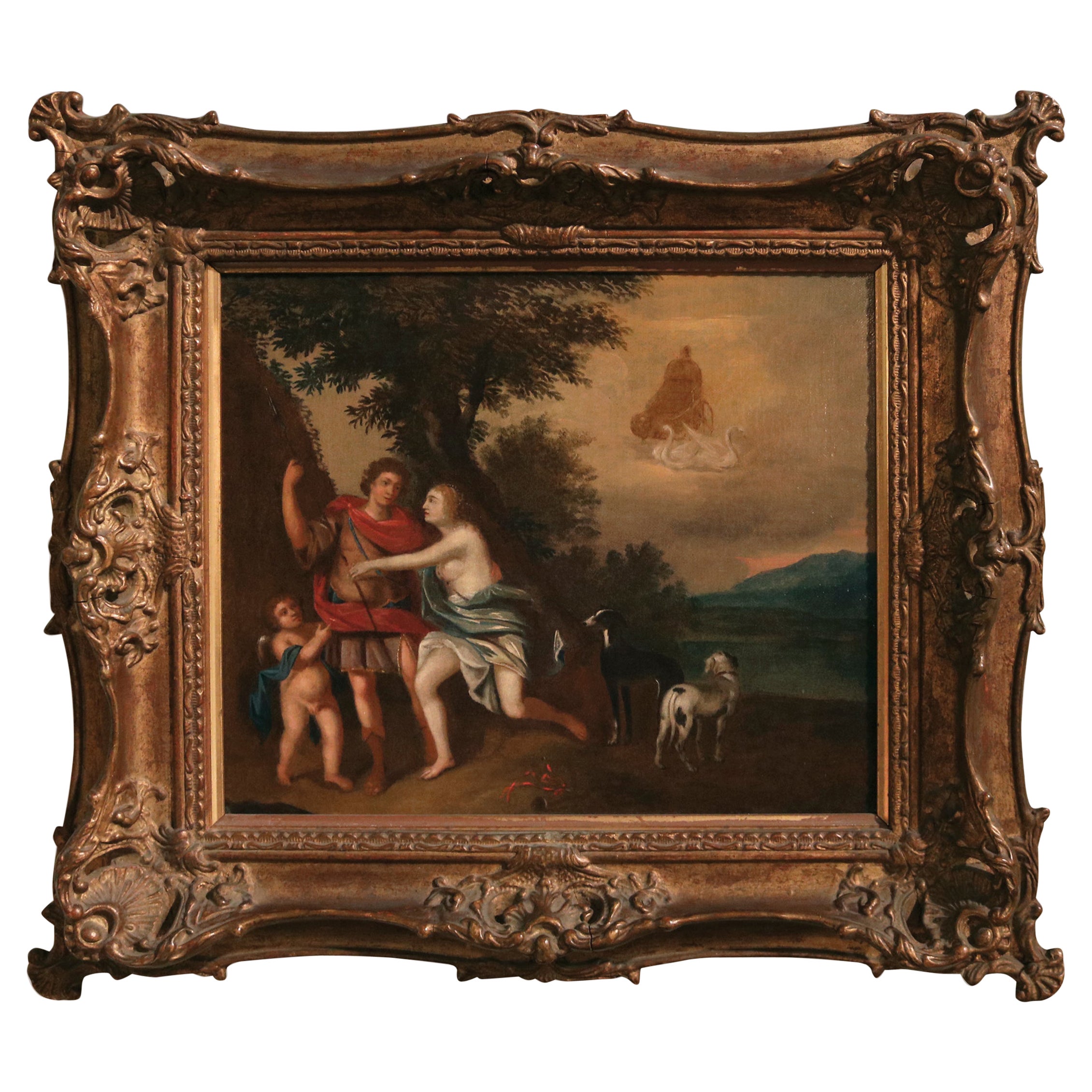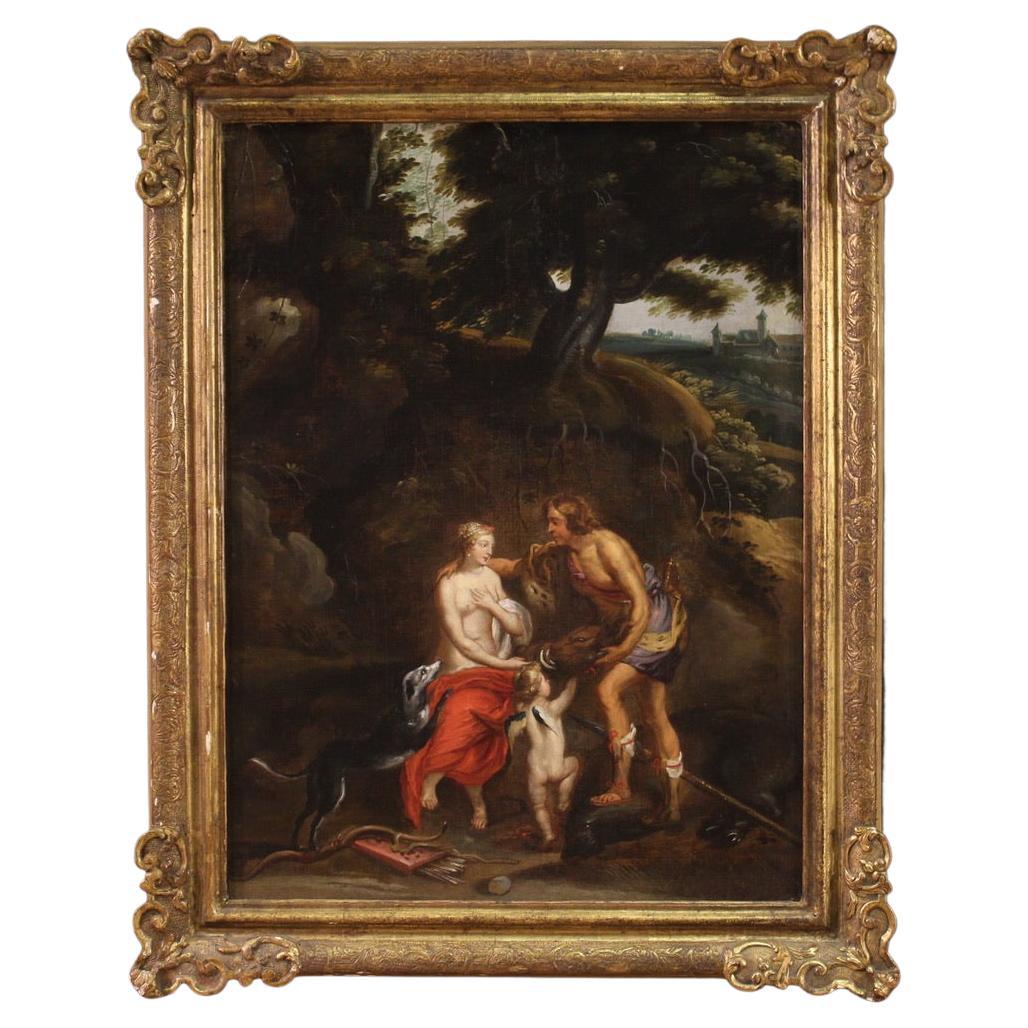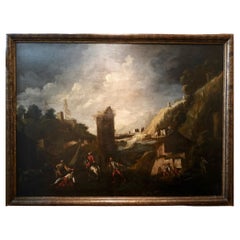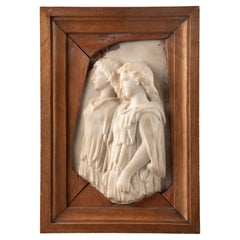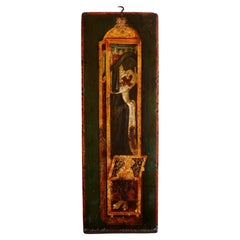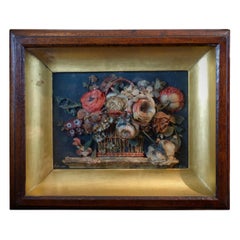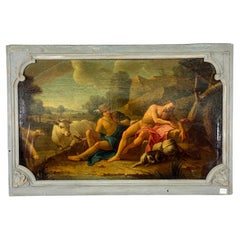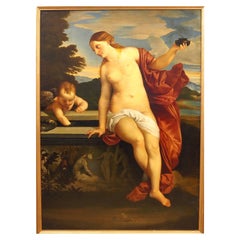Items Similar to Allegory of Africa - 16th century
Want more images or videos?
Request additional images or videos from the seller
1 of 6
Allegory of Africa - 16th century
$67,096.04
£49,948.64
€56,000
CA$91,904.80
A$102,218.20
CHF 53,375.17
MX$1,243,886.79
NOK 681,682.35
SEK 639,297.78
DKK 426,308.45
Shipping
Retrieving quote...The 1stDibs Promise:
Authenticity Guarantee,
Money-Back Guarantee,
24-Hour Cancellation
About the Item
Flemish school of the 16th century
Allegory of Africa
After The Allegories of the Continents by Maerten de Vos (engraving by Adriaen Collaert)
Oil on copper
Inscription: "Giulio Romano" on the back
Dimensions: 29.5 x 24.5 cm
(without frame)
Provenance: Private collection, Florence, Italy
The Allegory of Africa is a stunning oil painting on copper, inspired by Adriaen Collaert’s engravings of the Four Continents (Metropolitan Museum of Art), which were based on the original designs by Maarten de Vos. In the late 16th century, as interest in atlases and maps grew, so did the desire to visually represent new geographical understandings. Allegorical depictions of the continents became a popular iconographic genre, reflecting the cultural and intellectual shifts brought about by the European age of exploration.
The attributes of the allegories was standardized in the runaway 1593 bestseller Iconologia by the Italian humanist Cesare Ripa (ca. 1555–1622) and supplemented by contemporary travel accounts.
In Collaert’s series, each continent is personified by a central figure accompanied by symbolic elements and a "characteristic animal": America rides an armadillo, Africa is seated on a crocodile, and Asia on a camel. In contrast, Europe is depicted atop a globe, symbolizing global aspirations rather than mere continental presence.
The illustrations of Africa and America reflect European perceptions of these continents as primitive (Africa is portrayed as semi-nude, unlike the richly dressed figures of Asia and Europe), yet also innocent, alluding to the possibility of discovering a new Eden beyond Europe.
While Africa’s skin appears fair in Collaert’s print, her tight curls and distinctive headdress evoke an exotic allure. This contrasts with the fair-skinned and delicate figure in our painting, which follows the archetype set by Cesare Ripa’s 1593 Iconologia. However, this model was not static and underwent modifications in subsequent editions. Notably, the 1613 Italian edition of the Iconologia reflected a growing awareness of sub-Saharan Africa, introducing darker skin tones that presented a more racialize and "tribal" depiction of the continent. This detail is crucial for dating our painting, suggesting it was created before 1613, when the iconographic model changed.
The background of our painting closely resembles that of Collaert and de Vos, featuring ancient ruins, such as Egyptian and Carthaginian structures. This alludes to Africa's distant yet sophisticated past, intertwined with both biblical and European histories.
The iconography of the Allegory of Africa is rich with symbolic meaning. In Collaert’s series, specific animals symbolize traits associated with each region—Africa’s crocodile emphasizes the untamed and exotic nature attributed to the continent which evokes both danger and the allure of the unknown. The chameleon suggests Africa’s tropical climate, while the lion and elephants (also featured in Ripa’s Iconologia) emphasize the continent’s exotic dangers. The presence of a cockatrice underscores how Africa was the least known of the continents in the imagination of 16th-century artists.
The allegorical figure of Africa in our painting, although adapted to European beauty standards, exudes strength and independence. This reflects the broader European narrative of the time, which romanticized the “other” while simultaneously positioning them as subjects for colonization. The depiction of a strong yet sexualized female figure illustrates the tension between admiration and exploitation that characterized colonial attitudes.
The painting demonstrates a fusion of Italian and Netherlandish artistic traditions. The inscription "Giulio Romano" on the back is an old attribution and suggests that the painting, likely commissioned by a prominent Italian collector, remained in the peninsula until today.
Italian influence is especially visible in the rendering of the central figure, with her blonde, wavy hair and delicate features, reminiscent of artists like Allori, the Medici court painter. However, the strong physique and detailed musculature, as well as the meticulous background details align more closely with Netherlandish traditions. This eclecticism blending Mannerist and realistic elements, mirrors the broader artistic environment of Antwerp during the early modern period, where artists were drawn to the city's cosmopolitan atmosphere and engaged with a wide variety of styles and subjects to meet the diverse tastes of its wealthy patrons.
Antwerp also became a leading center for printmaking, with de Vos being a prolific and influential print designer whose models, as this Allegory of Africa, constantly travelling around Europe. Artists like Martaens de Vos and his contemporaries traveled to Italy to study Renaissance art, blending these influences with the flemish tradition.
The artwork, through its adaptation of design by de Vos, illustrates how European artists engaged with and interpreted other cultures, shaping Western perceptions of Africa through allegorical figures and a fusion of artistic traditions.
- Dimensions:Height: 9.65 in (24.5 cm)Width: 11.62 in (29.5 cm)Depth: 1.19 in (3 cm)
- Style:Renaissance (Of the Period)
- Materials and Techniques:
- Place of Origin:
- Period:
- Date of Manufacture:16th century
- Condition:Wear consistent with age and use. modern frame.
- Seller Location:Bruxelles, BE
- Reference Number:1stDibs: LU6666243893122
About the Seller
5.0
Vetted Professional Seller
Every seller passes strict standards for authenticity and reliability
1stDibs seller since 2022
15 sales on 1stDibs
Typical response time: 4 hours
- ShippingRetrieving quote...Shipping from: Bruxelles, Belgium
- Return Policy
Authenticity Guarantee
In the unlikely event there’s an issue with an item’s authenticity, contact us within 1 year for a full refund. DetailsMoney-Back Guarantee
If your item is not as described, is damaged in transit, or does not arrive, contact us within 7 days for a full refund. Details24-Hour Cancellation
You have a 24-hour grace period in which to reconsider your purchase, with no questions asked.Vetted Professional Sellers
Our world-class sellers must adhere to strict standards for service and quality, maintaining the integrity of our listings.Price-Match Guarantee
If you find that a seller listed the same item for a lower price elsewhere, we’ll match it.Trusted Global Delivery
Our best-in-class carrier network provides specialized shipping options worldwide, including custom delivery.More From This Seller
View AllAntonio Travi Called Le Sestri, Seascape with Ruins, Genoa 17th Century
Located in Bruxelles, BE
Antonio Travi called Le Sestri (Sestri Ponente, 1608 - Genova 1665)
Seascape with ruins
Genova, First half of 17th century
Oil on canvas with his original 17th century frame
M...
Category
Antique 17th Century Italian Baroque Paintings
Materials
Canvas
Renaissance relief - Italy, probably Rome, 16th century
Located in Bruxelles, BE
Renaissance relief depicting two female figures dressed in a chiton
Italy, probably Rome, 16th century
Marble, wooden frame (provenance label on the back)
28 x 20 x 5 cm
This beau...
Category
Antique 16th Century Italian Renaissance Wall-mounted Sculptures
Materials
Marble
Bolognese School of the 16th Century - Mummy of Saint Catherine of Bologna
Located in Bruxelles, BE
Bolognese School of the 16th Century
Mummy of Saint Catherine of Bologna
Oil on Panel
20,5 x 7 x 0,8 cm
This rare painting depicts Saint Catherine of Bologna as a mummy, housed in a ...
Category
Antique 16th Century Italian Renaissance Paintings
Materials
Wood, Giltwood
$3,354 Sale Price
20% Off
Free Shipping
Wax Relief, Italy 19th Century
Located in Bruxelles, BE
Wax relief depicting a vase with flowers
Italy, mid-19th century
Signed "Scot. inv et fecit"
Measures: 37 x 44 x 7,5 cm.
Category
Antique Mid-19th Century Italian Early Victorian Wall-mounted Sculptures
Materials
Wood
$2,878 Sale Price
20% Off
Large Terracotta Relief - Lombardy, First Half of 17th Century
Located in Bruxelles, BE
Large Terracotta relief of the flight into Egypt
Lombardy, first half of 17th century
Painted terracotta
91 x 85 x 11,5 cm
This event in the early life of Christ is recounted i...
Category
Antique 17th Century Italian Baroque Figurative Sculptures
Materials
Terracotta
$62,357 Sale Price
20% Off
Renaissance Harpy - Italy, 16th century
Located in Bruxelles, BE
Renaissance Harpy
bronze
Italy, 16th century
15 x 12 x 5,5 cm
This expressive bronze figure represents a harpy, a mythological creature with the body of a bird and the head and tor...
Category
Antique 16th Century Italian Renaissance Figurative Sculptures
Materials
Bronze
You May Also Like
18th Century French Greco Roman Mythological Painting
Located in Scottsdale, AZ
18th Century French Greco Roman Mythological Painting
Beautiful & Large piece purchased in France.
This scene was taken from the Metamorphosis of Ovid.
Inner Frame Dimensions: Hei...
Category
Antique 18th Century French Greco Roman Paintings
Materials
Wood, Paint
Beautiful 19th Century French School "Allegory"
Located in Madrid, ES
19th Century French School "Allegory".
Oil on canvas.
Size 136 x 98 cm.
good condition
Category
Antique 19th Century French French Provincial Paintings
Materials
Paint
17th Century, Italian Painting by Pier Francesco Cittadini, Jacob and his Family
Located in IT
Pier Francesco Cittadini (Milan, 1616-Bologna, 1681)
"Jacob and his family go to Egypt"
Oil on canvas, cm 109 x 190 (canvas only)
The valuable painting, made in oil on canvas, depicts Jacob and his family go to Egypt and we believe it can be, given the high quality painting, autograph work of Italian Pier Francesco Cittadini (Italy Milan, 1616 - Bologna, 1681) made after 1647. The work, in excellent condition is accompanied by a coeval frame in wood finely carved and golden.
The scene depicted, which was confused with the Flight to Egypt in the past years, is instead identified with the biblical episode of Jacob’s journey. In the foreground, reading the painting from left to right, we see a caravan composed of animals, including donkeys, dromedaries, goats, dogs and horses and people, women, men and slaves, who carry on their journey along the banks of a river, following a path that to the right, would seem to lead to the through of a bridge. In addition to the watercourse is described an environment characterized by large rocks and impervious come far to cover the entire verticality of the canvas. On the left, in the distance, we see the tail of the caravan that runs along the steep path. Large trees enliven and harmonize the environment, as well as white and grey clouds characterize the predominantly clear sky and illuminated on the right by sunlight.
The story is told in the Bible, Book of Genesis, 30, 25, passage in which is described the flight of Jacob from Haran after the contrasts with Laban, father of his wife Rachel. Jacob is the third great patriarch of the Bible. From his descendants originate the twelve generations of the people of Israel. He is the son of Isaac and Rebekah, who led him to flee from the wrath of Esau to Haran to seek refuge from his brother, Laban. At his uncle’s house Jacob met his daughter Rachel. As soon as he saw his cousin, Jacob was taken. Jacob will stay seven years in the service of Laban to marry his beloved Rachel. But Laban, with a deception, will give him in marriage first Lia, the least beautiful eldest daughter, and only after another seven years the splendid Rachel. From his first wife he will have several children, while Rachel will give birth to the beloved son, Joseph, who will become viceroy of Egypt.
After years of service, Jacob asked to be paid with every dark-coloured garment among the sheep and every spotted and dotted garment among the goats. Laban accepted and sent away from his sons all the leaders of that kind. So Jacob took fresh branches of poplar, almond and plane tree, and flayed them, and put them in the troughs. The optical suggestion induced the goats and the sheep to conceive and give birth to dark, striped and dotted garments. He also ensured that all the strongest and healthiest leaders of the flock of Laban would drink near the barked branches, thus assuring a genetic superiority to his part of the flock. His flocks grew numerous and strong and he became richer than his relative, arousing envy. It was clear that Laban would not respect him much longer. At the suggestion of the Lord, Jacob decided to return to Canaan. Trying to avoid any possible dispute, he left with his family while Laban was absent for shearing sheep. But when, three days later, his uncle returned home, he became angry, feeling offended because Jacob had gone secretly and had not allowed him to greet his daughters and grandchildren. In addition, his teraphim, statuettes, or idols, which depicted the family deities, had disappeared. After 7 days of pursuit, Laban and his men reached Jacob’s group on Mount Gilead, in the mountainous region west of the Euphrates River, where his uncle and grandson had a stormy conversation. The younger man was outraged at being accused of stealing idols and told Labano to rummage through his family’s tents at will. Neither of them could know or even imagine that it was Rachel who took the idols and hid them in the saddle of the camel. During the search, she sat down firmly on the saddle, apologizing for not being able to get up, «because I usually have what happens to women» (Gen 31:35). So the loot wasn’t discovered.
The author of this work was inspired by the composition of an engraving by Stefano Della Bella (1610-1664) of circa 1647. The engraving by Stefano della Bella bears the title "Iacob sur ses vieux jours quitte sans fascherie pour voir son filz Ioseph, sa terre et sa patrie" and is signed on the bottom left "Stef. of the Beautiful In. et fe." while on the right it is declared "Cum privil. Regis", that is with license of the king.
Stefano Della Bella (Italy - Florence, May 18, 1610-Florence, July 12, 1664) was born in a family of painters, sculptors and goldsmiths and was left early orphan of his father sculptor, he dedicated himself first to the art of goldsmith at the school of Giovanni Benedetto Castiglione and Gasparo Mola, then turning his attention to drawing and engraving. He soon began drawing figures and copying the etchings of Jacques Callot, which inspired his early works. Under the protection of the Medici, in particular of Don Lorenzo, cadet son of Grand Duke Ferdinand I, Della Bella has the opportunity to make study trips to Rome, where he stayed from 1633-1636; In Rome he met French engravers and publishers of prints such as Israël Henriet and François Langlois, who influenced his decision to move to Paris in 1639, four years after the death of Callot. In Paris he soon reached, thanks to the engravings commissioned by Cardinal Richelieu, the success also worldly; he frequented courtiers, theatre artists and writers, while refusing too oppressive honors. In 1646-1647 he continued his travels in the Netherlands to Amsterdam, Antwerp and Dordrecht. He returned to Florence in 1650 and resumed working under the protection of the Medici court, working for his patrons. In 1656 he became a member of the Academy of Apatists.
The painting object of this study is reasonably attributable to Pier Francesco Cittadini, or Pierfrancesco Cittadini, called the Milanese or the Franceschino (Italy - Milan, 1616-Bologna, 1681) as some exemplary stylistic comparisons proposed to follow can prove.
Pier Francesco Cittadini was an Italian baroque painter, mainly active in Bologna.
His artistic training first took place with the painter Daniele Crespi...
Category
Antique Mid-17th Century European Baroque Paintings
Materials
Canvas, Giltwood
18th Century oil painting from the Sschool of Jan van Neck
Located in London, GB
An early 18th century oil painting from the school of Jan van Neck (1635-1714), Amsterdam, depiction mythological subjects, probably Venus, Cupid and Mars wit...
Category
Antique Early 18th Century Dutch Other Paintings
Materials
Paint
18th Century Oil Painting from the School of Jan Van Neck
Located in London, GB
An early 18th century oil painting from the school of Jan van Neck (1635-1714), Amsterdam, depiction mythological subjects, probably Venus, Cupid and Mars wit...
Category
Antique Early 18th Century Dutch Other Paintings
Materials
Paint
17th Century Oil on Canvas Flemish Mythological Antique Painting, 1660
Located in Vicoforte, Piedmont
A splendid 17th century Flemish painting. Oil on canvas artwork depicting a mythological subject of great charm, Meleager offers the boar's head to Atalanta. The Fates had predicted ...
Category
Antique 1660s Dutch Paintings
Materials
Canvas
$8,634 Sale Price
20% Off
Free Shipping
More Ways To Browse
Lion Dress
Crocodile Dress
Elephant Skin Furniture
African Crocodile
Cubist Cabinet
Deruta Majolica
Dior Fine China
Drexel French Furniture
Drexel French
English Country Chest Of Drawers
English Oak Nightstand
Entryway Organizer
Erik Hoglund Kosta Boda
Ethiopian Wood
Faux Bois Chairs
Flip Top Teak
Floyd Furniture Used
Fountain Face
